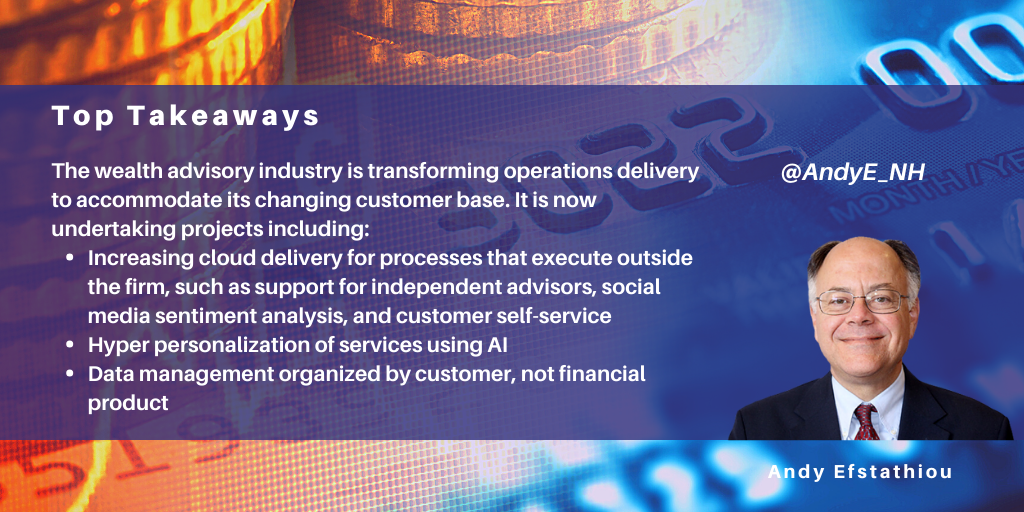posted on Jan 29, 2024 by Andy Efstathiou

Financial institutions are rapidly starting or growing existing wealth and asset management businesses. In the U.S., wealth assets under third-party management have grown over the last five years by 16.8% CAGR to 2023 (Source: Statista). Wealth advisors are looking to continue to invest in and grow their wealth management businesses because they see continued growth coming from:
- Generational transfer of wealth from baby boomers to younger generations. The estimated transfer of wealth is $84 trillion over the next 20 years (per Cerulli Associates)
- Perceived risk of an economic downturn by the management of financial institutions. This would lead to significant losses in risk portfolios for the banks. However, wealth management is a fee-based business and not subject to capital losses.
NelsonHall’s operations research finds new customer demographics can be profitably served with digitalized service delivery. These customer demographics are the mass affluent and the unbanked. Government initiatives such as India’s program to issue Aadhaar numbers to all citizens enable previously unbanked citizens to access financial services. Governments are moving towards individual retirement funding, necessitating individuals to start saving. Digitalization of service delivery allows profitable service delivery to a much larger mass affluent customer base.
Changing customer base
The growth in the wealth advisory industry is driven by a changing customer base, which has very different priorities and expectations from the traditional wealth client base. Key new customer priorities are:
- Investments that reflect the client’s values. Examples include investments that score well on ESG and transparency. Weaknesses in effective scoring and benchmarking these attributes remain a challenge
- Digital engagement with advisors. Today’s customers are familiar with digital engagement and expect to have it across their entire environment. Currently, most younger wealth management customers are unhappy with the quality and functionality of their wealth managers’ digital interaction offerings
- Digital tools to educate themselves and provide portfolio and return attribution analyses. The quality of these tools varies widely across wealth managers. Current tools are perceived as inflexible and lacking functionality
- Support for multiple family members. Wealth managers no longer interact with one founder as wealth is transferred to the next generation. As multiple family members are active in decision-making and often pursue different goals from each other, the wealth managers need to support cooperation between family members and customize services for individual needs
- Easy to understand investment strategies. Many investment advisors previously advised on complex investment strategies and structured instruments. Today, investors are looking for simpler investment strategies, such as indexing, to deliver investment performance for them.
These customer priorities and the operational challenges that inhibit them from achieving their goals are driving new initiatives in the industry to enable wealth managers to change their business models and deliver new services.
New wealth & asset management initiatives
New industry initiatives include:
- Cloud delivery for processes that execute outside the firm. Examples include shifting processes to the cloud, which supports external users, especially:
- Third parties such as independent wealth advisors (in the U.S., they are known as Registered Independent Advisors or RIAs) who sell services directly to the financial institution's customers. Cloud-delivered services are efficiently delivered anywhere and offer multiple solutions using APIs to accommodate the legacy solutions of the independent advisor
- Social sentiment collection, analysis, and reporting. Increasingly, investments are being evaluated using social sentiment as part of the analysis. Hyperscalers are delivering AI tools to support the analysis of social sentiment as part of their overall service offerings
- Direct-to-customer data access. As clients increasingly demand more self-service, they need access to both data and AI tools to perform their custom analysis. Hyperscalers have developed ecosystems with both data vendors and AI solution vendors that customers can access to create their custom analysis
- Compliance services that are perceived as a non-differentiating cost. That cost can be minimized by sharing best practices and utilizing a shared environment. In the past, the industry shared best practices in industry forums. Cloud delivery enables industry participants to share infrastructure and best practices continually. Cloud also enables real-time response to threats and deadlines to be shared faster and more effectively
- AI is being deployed to bring highly personalized offers to customers. Examples are the use of AI to:
- Support advisors in developing investment plans for customers
- Enable customers to shop investment offerings using self-service
- Enable customers to do independent investment analysis
- Data management is changing from a siloed approach by investment product type to data collection, analysis, and reporting organized by customer.
These operational transformation initiatives make wealth and asset managers directly accessible to third parties, including customers and business partners. The changes will bring many startup service providers to the wealth management industry. Ultimately, IT services vendors supporting the industry will need to be able to support the IT needs of tiny enterprises to continue effectively servicing the industry. That, in turn, will drive significant change in the IT services industry.
